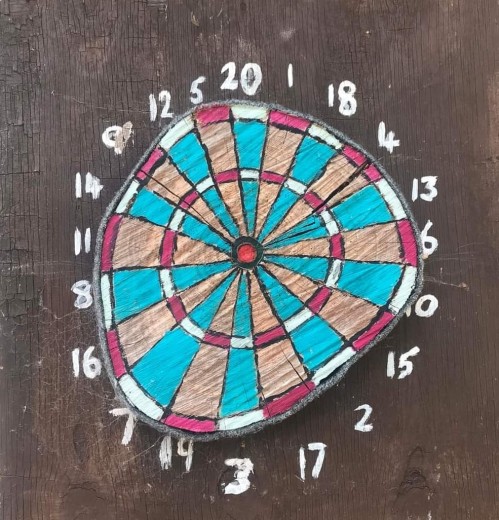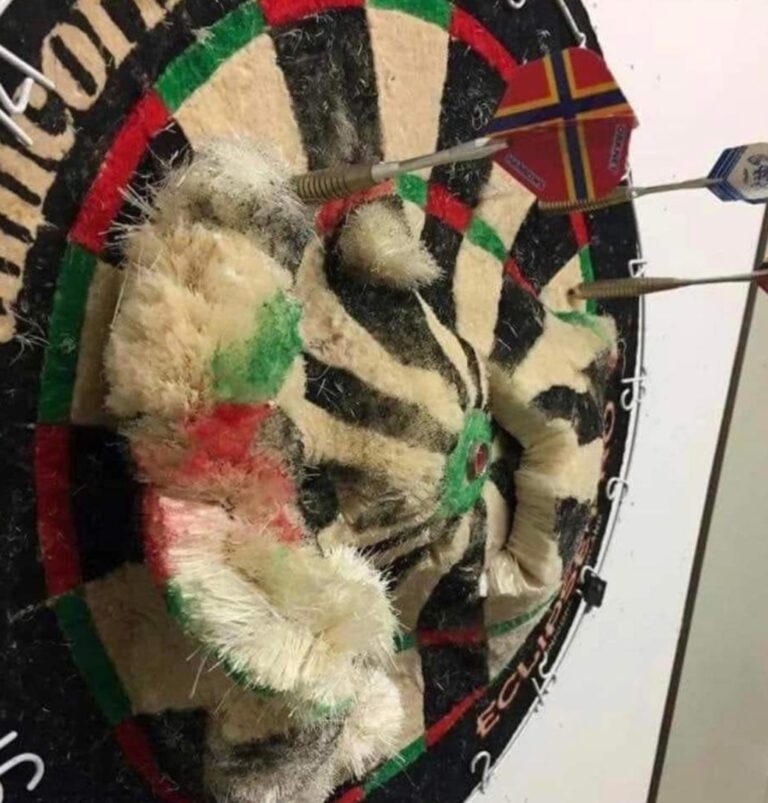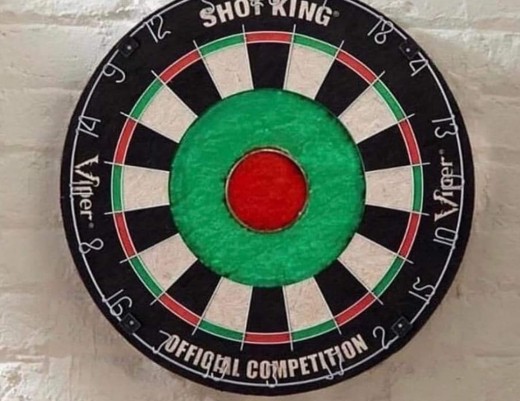Saturday, April 1, 2017
Column 534
Fidel Castro, Ernest Hemingway, and Darts in Cuba
“Entering a totalitarian state,” wrote a recent traveler to Cuba of his arrival at Havana’s José Martí International Airport, “I expected more militaristic security. Instead, I was warmly welcomed by female immigration and security agents wearing uniforms that included shorts and patterned fishnet stockings. It was the first of many surprises, mostly pleasant surprises, I experienced…”
And so it was for Dartoid’s World, a few months ago just after President Obama’s and the Rolling Stones’ historic visits to this lush tropical island, once the play land of the rich and famous, just 90 miles off the southernmost tip of Key West, Florida. Mostly business but partly yet another leg in my quest for Holy Grail – the perfect game in the perfect darts-dive (and, of course, the perfect beer) – the journey was one of the most fascinating in all my years of travel.
Regrettably, and despite extreme diligence I did not find the perfect beer. The same cannot be said for mojitos.
My driver was a lawyer. The girl who checked me into my hotel was a civil engineer. I met a waitress who was a doctor (one of 70,000 on the island – the vast majority of whom do not practice). And this was one of the fascinating things. Education is free. Literacy is near 100%. Cuba’s 11 million-plus population is possibly the most educated in the world. The problem is there are no jobs. The average monthly wage is about $20. People have to hustle to make a buck.
Cuba is a land of incredible inefficiency. There are two forms of currency – pesos and convertible pesos, neither of which are exchangeable in foreign markets. American credit cards are useless. The Internet basically doesn’t work. Well, it does but you need to find wifi (not an easy task) and have managed to purchase a special card (also a difficult task) with a code to log in. And then it works, kind of, sometimes. The most basic goods are nowhere to be found. I was told of a young mother who searched five stores for diapers for her newborn child and finally gave up. Someone else told me they saw a boy walking with a box of pizza and asked him where to get one. “The kid yelled over to an older, shirtless, shoeless man sitting on a bench who shouted the directions.” The Cuban Google.
Cuba is also a land of breathtaking beauty. I took a day trip east along the northern coast from Havana to the resort community of Varadero. Some call it the “trip through paradise” and with good reason. I couldn’t help but marvel at the exotic flowers, colorful birds, and pristine beaches. Varadaro is only a couple miles in length and quite narrow – at many points you can almost touch the ocean on both your left and right and feel the breeze as it wafts through the palms.
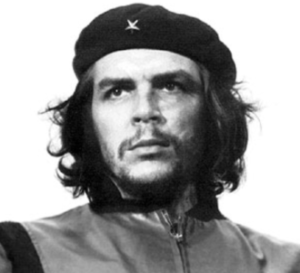 Everywhere – in offices, on the sides of buildings, along the freeway – there are images of Fidel Castro and Che Guevera. It’s just the way it is. It got me to thinking, sometimes a dangerous thing. The charismatic, good looking, bushy-haired and bearded image of Che was once proudly sported on t-shirts – a very popular item worn by left-leaning kids around Haight Ashbury and on college campuses in the 1960s. Today, shirts and related paraphernalia can still be found on eBay.
Everywhere – in offices, on the sides of buildings, along the freeway – there are images of Fidel Castro and Che Guevera. It’s just the way it is. It got me to thinking, sometimes a dangerous thing. The charismatic, good looking, bushy-haired and bearded image of Che was once proudly sported on t-shirts – a very popular item worn by left-leaning kids around Haight Ashbury and on college campuses in the 1960s. Today, shirts and related paraphernalia can still be found on eBay.
One must wonder what did these kids know. For social justice, against the war in Vietnam, as opposed to Richard Nixon as many are today to Donald Trump – surely they were all of this. But did they know the truth about Che? Former British Prime Minister James Callaghan once wrote, “A lie can be halfway around the world before the truth has its boots on.” It has since been written that “… the truth about Che now has its boots on.”
What Che had was a good public relations department. Somehow he became revered as some sort of “hipster icon, counter-culture hero, anti-establishment rebel, and champion of the poor” when in fact he was Fidel Castro’s executioner, a mass-murderer.” He ruthlessly killed thousands, including women and children. Cubans seem to love him. They have no choice.
In a way this crazy disconnect, this misinformation promulgated by fancy marketing conjures an image of so many macho, tattooed darts guys traveling about the country wearing Red Eye Rhino shirts without a clue what Red Rhino actually means. Google “Red Rhino, urban dictionary” and be enlightened. Perhaps this is some strange and unfortunate coincidence or some quirk caused by a squirrel crossing the space-time continuum? Sure, this all makes sense. And Che was a saint.
NOTE: The above is just the tip of the broader Red Eye Rhino story. The charade, narcissism and misrepresentations, the swath of discontent among players across America, is deep and wide. Watch this space.
I was told of a another couple who was walking down a sidewalk in Old Havana “…looking for a street name that is usually affixed to corner buildings.” The man remarked to his wife, “It looks like the street name fell off the building.” She replied, “It looks like the building fell off the building.” There is a lot of rubble. It is oddly beautiful.
Yes, there are vintage 1940s and 1950s American cars everywhere. But as shiny, as gorgeous as they are on the outside, “…their insides are assembled from a hodgepodge of parts that click, clank, hiccup, and spew diesel smog into the air.” Old motorcycles have side-cars.
Music, dance, and cigars are around every corner. And mojitos. I found a couple of boxes of maduros for Gordon Dixon and the Old Dart Coach and then made my way to where I was told could be found the best mojito in the country – the famous, or infamous, Hotel Nacional. Before the Revolution the Nacional was at the epicenter of “decadent jet-set heaven” – when in the words of Cuban historian Louis Perez, “Havana was what Vegas has become.”
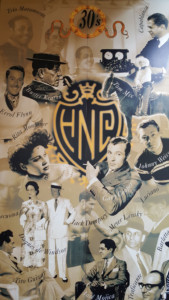 I wasn’t steered wrong. In the small hotel bar I sipped a superb couple of drinks surrounded by floor to ceiling murals of many of those who once did the same while on break from the casinos, cabarets, and prostitutes. In the 1940s, Lucky Luciano and Meyer Lansky held court here. Marlon Brando, Rita Hayworth, John F. Kennedy, Frank Sinatra, Mickey Mantle, Fred Astaire, Jack Dempsey, and Ernest Hemingway – the list is endless. They all partied at the Nacional.
I wasn’t steered wrong. In the small hotel bar I sipped a superb couple of drinks surrounded by floor to ceiling murals of many of those who once did the same while on break from the casinos, cabarets, and prostitutes. In the 1940s, Lucky Luciano and Meyer Lansky held court here. Marlon Brando, Rita Hayworth, John F. Kennedy, Frank Sinatra, Mickey Mantle, Fred Astaire, Jack Dempsey, and Ernest Hemingway – the list is endless. They all partied at the Nacional.
Speaking of Hemingway and given that, sadly (except for the one I carried from home) I was unable to find a single dartboard in the city, I headed next to a bar called the Floridita. This is when my trip became truly fascinating…
Hemingway drank here in the day with the likes of Spencer Tracy, John-Paul Sartre, Ava Gardner, and Errol Flynn. There are photos of the author everywhere. At the far corner of the bar there is a life-sized bronze statue of Papa waiting to be served, a book and his glasses on the shiny wooden counter in front of him. To the right on a tiny stage a local group played “Guantanamera” and other favorites while patrons puffed cigars and danced among the tables.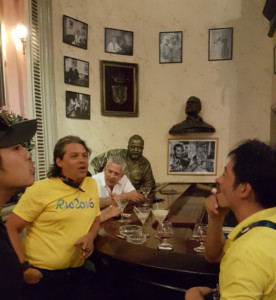
Periodically, someone would approach the statue to take a selfie, which of course I had to do.
That’s when I saw it.
There on the wall just behind the bronze was a grainy photo of Hemingway and Castro each holding an armful of trophies. Between them, just behind Hemingway’s right shoulder, was a dartboard. Unmistakable. Unbelievable. I couldn’t believe my eyes.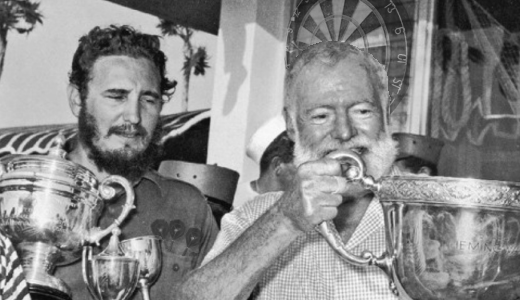
For three days and nights I had pounded the streets of Havana in search of some darts action, to no avail. Yet here at the Floridita, totally unexpected, was proof not only that the game existed, at least once upon a time, but that Castro and Hemingway, fast friends from the day they met, were on a team together – a winning team!
I knew Castro was an accomplished baseball player.
I knew Hemingway was a big game hunter, fished for marlin, and had a bunch of cats with six toes.
But darts?
To the side of the photo array was a plaque etched with a (slightly edited) inscription about the “Conquistadors – Castro’s and Hemingway’s long-forgotten darts team. The line is from the poem by the famous English poet, John Donne – from whom Hemingway borrowed the title for his best-selling novel, For Whom the Bell Tolls…
Nunca preguntes por quién doblan las campanas; doblan por ti (el primero de abril). [And therefore never send to know for whom the bell tolls; it tolls for thee (on April 1st).]
From the Field,
Dartoid

